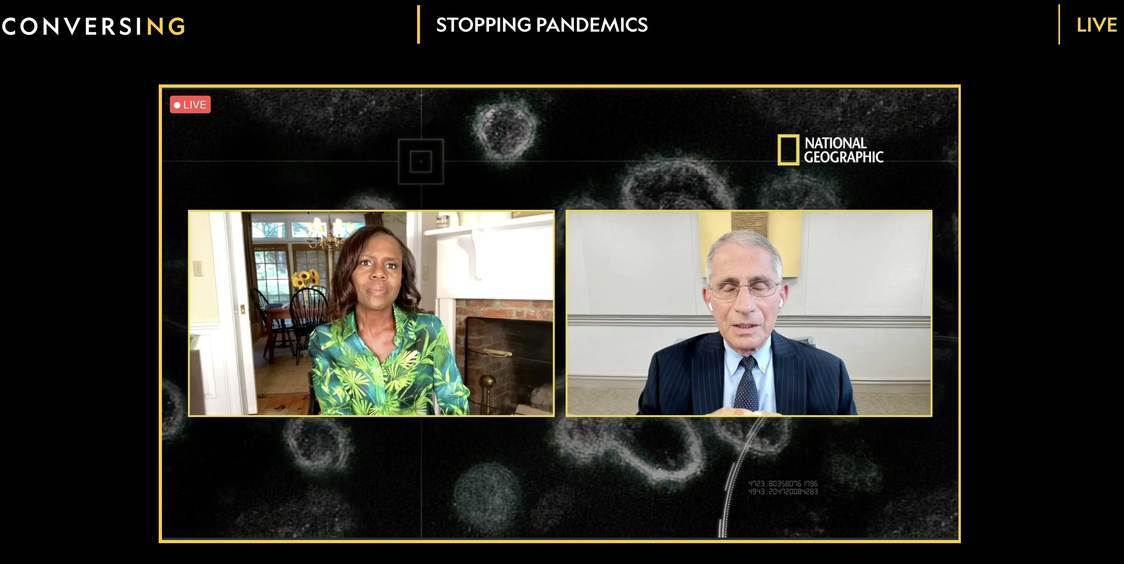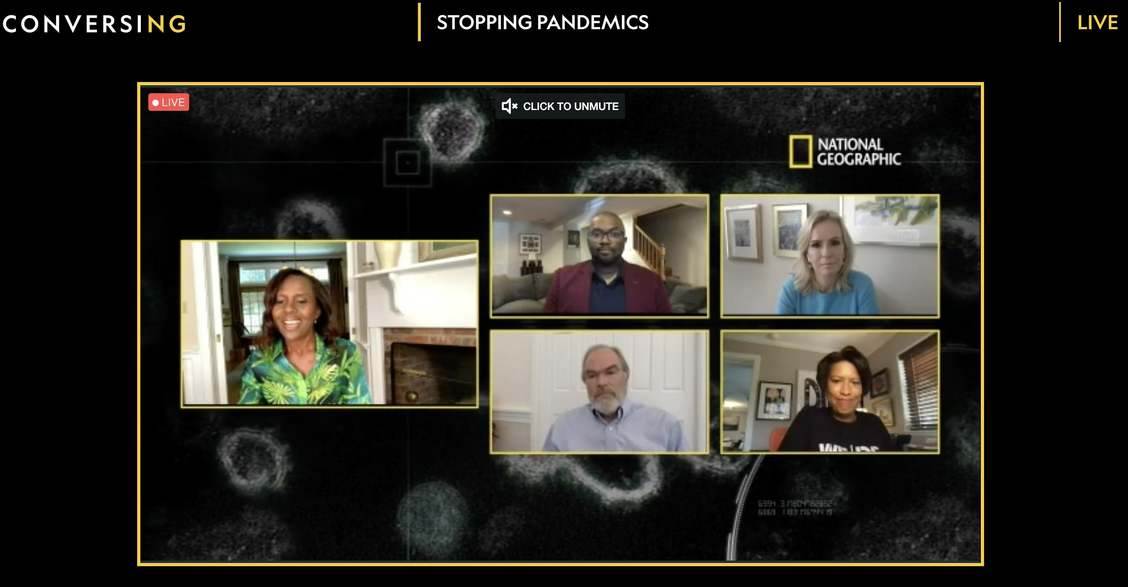Stopping Pandemics: National Geographic and ABC News Host Dr. Anthony Fauci For an Important Live Conversation
National Geographic hosted a special webinar called “Stopping Pandemics” on August 13th, a collaboration between ABC News and Nat Geo contributors along with special guests Dr. Anthony Fauci and Washington D.C. Mayor Muriel Bowser. The engaging conversation primarily covered topics related to what we could do better as a nation and a realistic estimate of what the future holds. The presentation was moderated by Deborah Roberts from ABC News.
Dr. Anthony Fauci’s first question was about the way the U.S. has handled the pandemic, which he is dissatisfied with. He pointed to several European countries who handled a nationwide phased reopening successfully. He sees some hope from the states that had the biggest spikes after a swift reopening, which are now on a downward trend, but is also concerned with states that previously didn’t have a big problem where cases are now on the rise. This up and down trend will continue unless the entire country works together.
The biggest issue, according to Dr. Fauci, is the inconsistency of what we’re doing. National Geographic Science Editor Nsikan Akpan talked later in the presentation about the patchwork of responses, with all fifty states doing their own thing and counties within some states acting on their own. All of this makes it harder to test, trace, and isolate cases. It also creates distrust in public health guidelines when you have some areas following them closely and others ignoring them.
Dr. Fauci added some historical experience to the conversation, talking about the different types of outbreaks he’s helped the nation through over the past four decades. This is the only one he’s seen where the range of impact is so varied where you can have 40% of affected persons display no symptoms. He said while it is true that young people statistically do better with the virus, we are seeing more young people with health issues and long term effects as a result of having COVID-19.
Adding to the historical perspective was writer Richard Coniff, who has an article about pandemics in the most recent issue of National Geographic magazine and is also writing an upcoming book about them. He was one of the first kids to receive the polio vaccine in 1955 while in grade school and says people have forgotten the consequence of these diseases with most doctors today having never seen a case of diphtheria. At the height of that disease, it was not uncommon for families to lose all of their children within days of each other. Because we haven’t had a major outbreak like that in so long, we’ve allowed our public health structure to deteriorate with the agency Predict closing its doors in October 2019, an organization that existed to prevent and predict outbreaks like this. They went out of business just as cases of COVID-19 were beginning in China.
With the topic of Coronavirus cases in children, the conversation shifted to schools safely reopening. Dr. Fauci agrees that it’s important to get kids back in school for a variety of reasons, but that the primary consideration has to be the health and safety of students, teachers, and the people they interact with outside of the school environment. In areas deemed a yellow zone, guidelines to reopening should include staggered class hours, outdoor classes when possible, and less crowded indoor classrooms. Red zones should carefully consider putting kids back in school, but the decision ultimately rests with parents and teachers. Dr. Fauci believes most parents and teachers want to follow CDC guidelines for returning to school.
Mayor Muriel Bowser talked about how the decision to reopen schools was one of the most difficult ones to make during this whole process. She knows that online class isn’t an ideal substitute for in-person learning and to make the decision in her area, they had to balance what the health data was showing in addition to workforce confidence and parent confidence. For now, students in Washington D.C. will be spending their first term of the new school year online.
ABC News Chief Medical Correspondent Dr. Jennifer Ashton stressed that the pediatric age group has lower risk, but not zero risk. Tolerance of risk for parents is very low when it comes to their children and the numbers being reported represent real kids dealing with COVID-19. She talked about two aspects that aren’t getting enough media attention; Kids with special needs and the statistic that one-quarter of teachers have underlying medical conditions that make them more vulnerable. As of right now, the testing capability isn’t where it needs to be to help mitigate the risk.
The conversation also shifted to Russia’s claim that they have a COVID-19 vaccine ready to distribute. “Having a vaccine and proving that a vaccine is safe and effective are two different things,” Dr. Fauci stated. He hopes that the Russians have definitively proven that the vaccine is safe and effective, but doubts that it actually is based on the seemingly impossible timeline it was produced in.
Dr. Ashton shared some sound advice that if it sounds too good to be true, it probably is. As far as we know, a phase 3 trial where tens of thousands of volunteers test out a new vaccine hasn’t started in Russia and the worldwide scientific community will view it with skepticism until it is proven to have long term efficacy and safety. The fastest vaccine ever developed took four years and here in the US where at least three are already in phase 3 trials, it’s likely that several vaccines will hit the market at the same time.
Dr. Fauci also shared that we shouldn’t expect something with the same level of success as the measles vaccine because vaccines against respiratory diseases aren’t usually as effective. A 50% to 75% effective vaccine is probably the most likely outcome, which would still be very helpful. People should look at vaccines as an additional tool for getting us out of the pandemic, but it won’t end it all by itself.
In terms of what we can expect when vaccines are ready, the roll out will likely be slow. An advisory board for the CDC typically determines the priority of who gets it until there’s enough for everybody. Historically, new vaccines first go to healthcare providers and emergency responders, followed by the elderly and people with underlying conditions. As an extra level of security, the National Academy of Medicine is an independent group who will also be involved to make sure distribution of vaccines is done fairly.
As we head into the cold and flu season, Dr. Ashton shared a little bit of optimism. With so many American’s following health and safety guidelines by wearing masks in public, we could see a decrease in rates of the flu. We’ve never been in this situation before, so it’s a hypothetical guesstimate that could be a silver lining. The healthcare community is very concerned about dealing with two highly transmissible pathogens at the same time.
“This is going to end,” Dr. Fauci stated. With international role models available for the U.S. to follow from countries that have successfully decreased cases and reopened, the consistent message from these National Geographic and ABC News experts is clear. With consistent nationwide health and safety mandates, ramped up testing availability, and a phased approach to reopening based on lower numbers of infections, we can decrease the threat that the virus poses to our friends and loved ones. We all need to recenter our focus on getting through this time as a united nation.
Do you want to be notified about future live National Geographic events? Be sure to create an online account at NationalGeogaphic.com and sign up for their email alerts to stay in the know.


